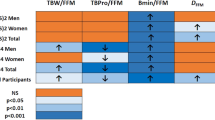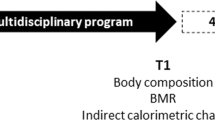Abstract
Background/Objectives:
Preliminary studies have reported an association between poor long-term outcome and lower total body fat percentage in weight-restored inpatients treated for anorexia nervosa (AN). A possible link between poor long-term outcome and higher trunk fat percentage has also been hypothesized. The aim was to assess the association between percentage and distribution of body fat at inpatient discharge and the maintenance of normal weight at 1-year follow-up in a sample of weight-restored females with AN.
Subjects/Methods:
Fifty-four short-term weight-restored (body mass index (BMI; in kg/m2) ⩾18.5) adult females with AN treated in a specialist inpatient unit underwent dual-energy X-ray absorptiometry to determine total body fat and trunk fat percentages. Patients were contacted regularly following discharge, and at the end of the year clinical outcome was dichotomized as either ‘full, good or fair’ (a group that includes individuals with a BMI ⩾18.5 kg/m2) or ‘poor’ (BMI<18.5 kg/m2), using the modified Morgan–Russell criteria.
Results:
No significant differences were found between ‘full, good or fair’ and ‘poor’ outcome groups in either total body fat or trunk fat percentages. Only lower BMI at inpatient discharge was associated with poor clinical outcome in the year following inpatient treatment.
Conclusions:
In short-term weight-restored adult females with AN, BMI, but not body fat percentage or distribution, at inpatient discharge is associated with long-term normal weight maintenance.
This is a preview of subscription content, access via your institution
Access options
Subscribe to this journal
Receive 12 print issues and online access
$259.00 per year
only $21.58 per issue
Buy this article
- Purchase on Springer Link
- Instant access to full article PDF
Prices may be subject to local taxes which are calculated during checkout
Similar content being viewed by others
References
Pike KM . Long-term course of anorexia nervosa: response, relapse, remission, and recovery. Clin Psychol Rev 1998; 18: 447–475.
Dalle Grave R, Calugi S, Conti M, Doll H, Fairburn CG . Inpatient cognitive behaviour therapy for anorexia nervosa: a randomized controlled trial. Psychother Psychosom 2013; 82: 390–398.
Strober M, Freeman R, Morrell W . The long-term course of severe anorexia nervosa in adolescents: survival analysis of recovery, relapse, and outcome predictors over 10-15 years in a prospective study. Int J Eat Disord 1997; 22: 339–360.
Keel PK, Dorer DJ, Franko DL, Jackson SC, Herzog DB . Postremission predictors of relapse in women with eating disorders. Am J Psychiatry 2005; 162: 2263–2268.
Carter JC, Blackmore E, Sutandar-Pinnock K, Woodside DB . Relapse in anorexia nervosa: a survival analysis. Psychol Med 2004; 34: 671–679.
Schebendach JE, Mayer LE, Devlin MJ, Attia E, Contento IR, Wolf RL et al. Dietary energy density and diet variety as predictors of outcome in anorexia nervosa. Am J Clin Nutr 2008; 87: 810–816.
Holtkamp K, Hebebrand J, Mika C, Heer M, Heussen N, Herpertz-Dahlmann B . High serum leptin levels subsequent to weight gain predict renewed weight loss in patients with anorexia nervosa. Psychoneuroendocrinology 2004; 29: 791–797.
Carter JC, Mercer-Lynn KB, Norwood SJ, Bewell-Weiss CV, Crosby RD, Woodside DB et al. A prospective study of predictors of relapse in anorexia nervosa: implications for relapse prevention. Psychiatry Res 2012; 200: 518–523.
Walsh BT, Kaplan AS, Attia E, Olmsted M, Parides M, Carter JC et al. Fluoxetine after weight restoration in anorexia nervosa: a randomized controlled trial. JAMA 2006; 295: 2605–2612.
Kaplan AS, Walsh BT, Olmsted M, Attia E, Carter JC, Devlin MJ et al. The slippery slope: prediction of successful weight maintenance in anorexia nervosa. Psychol Med 2009; 39: 1037–1045.
Mayer LE, Roberto CA, Glasofer DR, Etu SF, Gallagher D, Wang J et al. Does percent body fat predict outcome in anorexia nervosa? Am J Psychiatry 2007; 164: 970–972.
Bodell LP, Mayer LE . Percent body fat is a risk factor for relapse in anorexia nervosa: a replication study. Int J Eat Disord 2011; 44: 118–123.
Romero-Corral A, Somers VK, Sierra-Johnson J, Thomas RJ, Collazo-Clavell ML, Korinek J et al. Accuracy of body mass index in diagnosing obesity in the adult general population. Int J Obes (Lond) 2008; 32: 959–966.
Meeuwsen S, Horgan GW, Elia M . The relationship between BMI and percent body fat, measured by bioelectrical impedance, in a large adult sample is curvilinear and influenced by age and sex. Clin Nutr 2010; 29: 560–566.
Marzola E, Nasser JA, Hashim SA, Shih PA, Kaye WH . Nutritional rehabilitation in anorexia nervosa: review of the literature and implications for treatment. BMC Psychiatry 2013; 13: 290.
El Ghoch M, Calugi S, Lamburghini S, Dalle Grave R . Anorexia nervosa and body fat distribution: a systematic review. Nutrients 2014; 6: 3895–3912.
Mayer L . Body composition and anorexia nervosa: does physiology explain psychology? Am J Clin Nutr 2001; 73: 851–852.
Dalle Grave R . Multistep Cognitive Behavioral Therapy for Eating Disorders: Theory, Practice, and Clinical Cases. Jason Aronson: New York, 2013.
El Ghoch M, Milanese C, Calugi S, Pellegrini M, Battistini NC, Dalle Grave R . Body composition, eating disorder psychopathology, and psychological distress in anorexia nervosa: a longitudinal study. Am J Clin Nutr 2014; 99: 771–778.
El Ghoch M, Milanese C, Calugi S, Muller MJ, Pourhassan M, Ruocco A et al. Regional fat distribution in adolescent and adult females with anorexia nervosa: a longitudinal study. Clin Nutr 2014, e-pub ahead of print 23 December 2014; doi:10.1016/j.clnu.2014.12.012.
Fairburn C . Cognitive Behavior Therapy and Eating Disorders. Guilford Press: New York, NY, 2008.
Morgan HG, Russell GF . Value of family background and clinical features as predictors of long-term outcome in anorexia nervosa: four-year follow-up study of 41 patients. Psychol Med 1975; 5: 355–371.
Menard SW . Applied Logistic Regression. SAGE: Thousand Oaks, CA, 2002.
Metropolitan Life Insurance Company.. New weight standards for men and women. Stat Bull Metrop Insur Co 1959; 40: 1–4.
Bredella MA, Ghomi RH, Thomas BJ, Torriani M, Brick DJ, Gerweck AV et al. Comparison of DXA and CT in the assessment of body composition in premenopausal women with obesity and anorexia nervosa. Obesity (Silver Spring) 2010; 18: 2227–2233.
Mayer LE, Klein DA, Black E, Attia E, Shen W, Mao X et al. Adipose tissue distribution after weight restoration and weight maintenance in women with anorexia nervosa. Am J Clin Nutr 2009; 90: 1132–1137.
Bohler Jr H, Mokshagundam S, Winters SJ . Adipose tissue and reproduction in women. Fertil Steril 2010; 94: 795–825.
Golden NH, Jacobson MS, Schebendach J, Solanto MV, Hertz SM, Shenker IR . Resumption of menses in anorexia nervosa. Arch Pediatr Adolesc Med 1997; 151: 16–21.
Garfinkel PE, Lin E, Goering P, Spegg C, Goldbloom D, Kennedy S et al. Should amenorrhoea be necessary for the diagnosis of anorexia nervosa? Evidence from a Canadian community sample. Br J Psychiatry 1996; 168: 500–506.
Acknowledgements
We are grateful to our patients for their valuable contribution. We thank all the staff of Villa Garda Hospital, in particular Enrico Pinaroli, Marisa Molon, Adalgisa Zanetti and the entire nursing staff, for their assistance.
Author information
Authors and Affiliations
Corresponding author
Ethics declarations
Competing interests
The authors declare no conflict of interest.
Rights and permissions
About this article
Cite this article
El Ghoch, M., Calugi, S., Chignola, E. et al. Body mass index, body fat and risk factor of relapse in anorexia nervosa. Eur J Clin Nutr 70, 194–198 (2016). https://doi.org/10.1038/ejcn.2015.164
Received:
Revised:
Accepted:
Published:
Issue Date:
DOI: https://doi.org/10.1038/ejcn.2015.164
This article is cited by
-
Efficacy and tolerability of a specific blend of amino acids in patients with anorexia nervosa treated in a hospital setting: study protocol for a randomized controlled trial
Trials (2023)
-
Hypercapnia in hospitalized children and adolescents with anorexia nervosa as a predictive marker for readmission: a prospective study
Eating and Weight Disorders - Studies on Anorexia, Bulimia and Obesity (2023)
-
Polygenic association with severity and long-term outcome in eating disorder cases
Translational Psychiatry (2022)
-
Predictors of illness course and health maintenance following inpatient treatment among patients with anorexia nervosa
Journal of Eating Disorders (2020)
-
Inpatient weight curve trajectory as a prognostic factor among adolescents with anorexia nervosa: a preliminary report
Eating and Weight Disorders - Studies on Anorexia, Bulimia and Obesity (2018)



